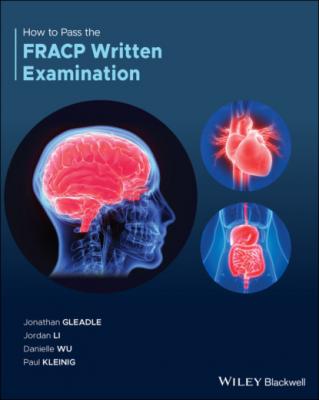How to Pass the FRACP Written Examination. Jonathan Gleadle
Читать онлайн.| Название | How to Pass the FRACP Written Examination |
|---|---|
| Автор произведения | Jonathan Gleadle |
| Жанр | Медицина |
| Серия | |
| Издательство | Медицина |
| Год выпуска | 0 |
| isbn | 9781119599548 |
Twerenbold R, Boeddinghaus J, Nestelberger T, Wildi K, Rubini Gimenez M, Badertscher P et al. Ref: JACC 70(8):996–1012.
Clinical Use of High‐Sensitivity Cardiac Troponin in Patients With Suspected Myocardial Infarction. Twerenbold et al.
2017;70(8):996–1012.
https://pubmed.ncbi.nlm.nih.gov/28818210/
35. Answer: B
This elderly woman is septic due to severe pneumonia. She has multiple cardiovascular risk factors. Her ECG shows ischaemic change, and the troponin level is elevated. This is a typical case of type 2 myocardial infarction (MI).
MI can be classified into various types, based on pathological, clinical, and prognostic differences, along with different treatment strategies:
Type 1: Spontaneous myocardial infarction
Spontaneous MI related to atherosclerotic plaque rupture, ulceration, erosion, or dissection with resulting intraluminal thrombus in one or more of the coronary arteries leading to decreased myocardial blood flow or distal platelet emboli with ensuing myocyte necrosis. The patient may have underlying severe coronary artery disease (CAD) but on occasion non‐obstructive or no CAD.
Type 2: Myocardial infarction secondary to an ischemic imbalance
In instances of myocardial injury with necrosis where a condition other than CAD contributes to an imbalance between myocardial oxygen supply and/or demand, e.g. coronary endothelial dysfunction, coronary artery spasm, coronary embolism, tachy‐/brady‐arrhythmias, anaemia, respiratory failure, hypotension.
Type 3: Myocardial infarction resulting in death when biomarker values are unavailable.
Type 4a: Myocardial infarction related to percutaneous coronary intervention (PCI).
Type 4b: Myocardial infarction related to stent thrombosis.
Type 5: Myocardial infarction related to coronary artery bypass grafting (CABG).
Patients with type 2 MI are frequently encountered in clinical practice and may be more common than type 1 MI. Diagnostic criteria for type 2 MI include:
Detection of a rise and/or fall of troponin values with at least one value above the 99th percentile, and evidence of an imbalance between myocardial oxygen supply and demand unrelated to acute coronary atherothrombosis, requiring at least one of the following:
Symptoms of acute myocardial ischaemia
New ischaemic ECG changes
Development of pathological Q waves
Imaging evidence of new loss of viable myocardium or new regional wall motion abnormality in a pattern consistent with an ischaemic aetiology.
The diagnosis of type 2 MI is associated with a poor prognosis: less than 40% of patients will live 5 years past their diagnosis. In contrast, 65% of patients with type 1 MI will survive for 5 years. This is because type 2 MI typically occurs among older patients with multiple comorbidities and is identified in the context of hemodynamic instability, including shock, tachycardia, respiratory failure, gastrointestinal bleeding, decompensated heart failure, or recent surgery. Moreover, in contrast to type 1 MI that has a clear set of guideline‐based recommendations for treatment, management of type 2 MI remains uncertain.
Although the benefits of antiplatelet agents, β‐blockers, and statins have been demonstrated among patients with type 1 MI, the utility of these medications among patients with type 2 MI remains uncertain. Currently, patients with type 2 MI are less likely to be discharged while taking these cardioprotective agents.
Reported prevalence of CAD among patients with type 2 MI varies with study design, ranging from 36% to 78%. About 30% of patients with type 2 MI experiencing major adverse cardiovascular events at 5 years, it is plausible that coronary revascularisation could be beneficial in those with obstructive CAD.
Thygesen K, Alpert J, Jaffe A, et al. Fourth universal definition of myocardial infarction (2018). European Heart Journal. 2018;40(3):237–269.
https://academic.oup.com/eurheartj/article/40/3/237/5079081
36. Answer: C
This patient's ECG, while in sinus rhythm 1‐year ago shows classic pattern of pre‐excitation – Wolff‐Parkinson‐White (WPW) syndrome. The ECG features a short PR interval; a slurred, thickened initial upstroke of the QRS complex, which is termed a delta wave; and a slight widening of the QRS deflexion with increased ventricular activation time. He presents with symptomatic pre‐excited atrial fibrillation (AF) with a rapid ventricular response requiring urgent treatment.
AF is a medical emergency when rapid antegrade conduction over an accessory pathway occurs in WPW syndrome. This is because the normal rate‐limiting effects of the atrioventricular (AV) node are bypassed, and the resultant excessive ventricular rates may lead to ventricular fibrillation and sudden death. The incidence of paroxysmal AF is between 10% and 38% in patients with WPW syndrome.
Urgent treatment for patients with WPW syndrome presenting with a tachydysrhythmia who are haemodynamically unstable, regardless of the QRS duration or regularity is direct current cardioversion. The electrical shock depolarises all excitable myocardium, lengthens refractoriness, interrupts re‐entrant circuits, discharges foci, and establishes electrical homogeneity that terminates re‐entry. Embolic episodes occur in 1–3% of the patients converted from AF to sinus rhythm if the episodes are longer than 48 hours. In those patients, anticoagulation must be addressed prior to cardioversion, with consideration of a transesophageal echocardiogram to exclude left atrial thrombus.
The acute treatment of pre‐excited AF WPW syndrome in a haemodynamically stable patient requires a rapid acting drug that can be given intravenously and can lengthen antegrade refractoriness and slow conduction in both the AV node/His‐Purkinje system and the accessory pathway. The class IC antiarrhythmic drugs such as flecainide which prolong the refractory period of the accessory connection are effective in this setting. Amiodarone, a class III antiarrhythmic drug, may also be used. AV node blockers (β‐blockers, non‐dihydropyridine calcium channel blockers and dıgoxin) are contraindicated for pre‐excited AF because inhibition of AV node conduction can increase pre‐excitation and lead to an increase in the ventricular rate and ventricular fibrillation. Intravenous adenosine is also contraindicated because it causes an effect similar to verapamil and can precipitate ventricular fibrillation. Catheter ablation is the recommended treatment for the long‐term therapy of pre‐excited AF.
Svendsen J, Dagres N, Dobreanu D, et al. Current strategy
